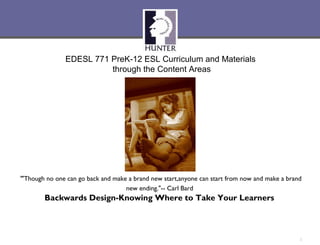
Curriculum&materials.backwards design
- 1. EDESL 771 PreK-12 ESL Curriculum and Materials through the Content Areas “"Though no one can go back and make a brand new start, anyone can start from now and make a brand new ending."-- Carl Bard Backwards Design-Knowing Where to Take Your Learners :Laura 1
- 2. Curriculum as a Road INPUT Linguistic Demands of Texts across the Content Areas OUTPUT Linguistic Demands of Tasks Instruction across the Content Areas chooses the destination and maps the course 2
- 3. Knowledge vs. Understanding Knowledge Understanding The facts The meaning of the facts A body of related facts Fallible, in-process theories Verifiable claims A matter of degree or Right or wrong sophistication I know something to be true I understand why it is, what makes it knowledge I respond on cue with what I I judge when to and when not to know use what I know Quantifiable, memorized, Abstracting, relating, interpreting reproducible Knowledge which is mainly second-hand…tends to become merely verbal. [To] the degree in which plan what is communicated cannot be organized into the existing experience of the learner, it becomes mere words: that is, lacking in meaning. Then it operates to call out mechanical reactions. (John Dewey, 1916) 3
- 4. Making Hard Choices rities onten t Prio Clari fying C Big Ideas and Core Tasks Important to know and do Worth being familiar with 4
- 5. What is “Understanding by Design”? • “Backward Design” focus: Clarify results and evidence of these results before designing lessons. • Teaching for understanding is the goal of teaching and compatible with standards-based curricula. • UbD is a way of thinking more carefully about design, not a program. • Thinking like an assessor, not only an activity designer, is key to effective design. • Overcoming the “twin sins” of “aimless activity” and “superficial coverage”. • The work is only “coverage” or “nice activity” unless focused on questions and big ideas, related to the Standards. 5
- 6. The Three Stages of Backwards Design 6
- 7. UbD Part 1: Identify the Desired Results-The Big Ideas Some Big Ideas by Type Concepts Economics- Its not the money you have, but how you allocate it. Themes Good triumphs over evil. Debates Winning is dependent upon offense vs defense. Perspective Life is shaped by your attitude; my cup half full or • What is it that you want your half empty. learners to understand at the Paradox Freedom involves responsibility. end of your unit? Theory Form follows function; you are what you eat. • What are the “Big” ideas/ Principle Less is more. enduring understandings that Assumption Non-fiction text always depicts truth. you want your students to arrive at, and essential questions to Some Big Ideas by Content guide student learning through the unit? Concept Big Idea nutrition You are what you eat westward expansion Hardship forged a nation persuasive writing Powerful media can influence beliefs and behaviors fairness Statistics can be manipulated to obscure the (mathematical) truth 7
- 8. Questions to Check if it’s a Big Idea Ask Yourself… oDoes it have many layers not obvious to the inexperienced learner? oDoes one have to dig deep to truly understand its meaning or implications? oIs it prone to disagreement? oMight you change your mind about it over time? oDoes it reflect the core ideas as judged by experts? 8
- 9. Using Essential Questions to Guide Students towards Big Ideas Essential Not Essential • What traits and • How many legs does a spider characteristics determine a have? classification? • Where do artists get their • Did nature influence Monet? ideas? • What determines value? • How many dimes in a dollar? • What distinguishes a fluent • What is the meaning of the foreigner from a native Greek term technology from its speaker? Greek root “techne”? • How does where we live • Why were settlements influence how we live? developed around lakes and 9
- 10. The UbD Template as Planning Support UbD Template for Content-Based ESL Unit Stage 1–Desired Results Content: Big Idea/Understandings: Essential Questions: Knowledge: Language: L/S/R/W Skills/Function: Grammar: Target vocabulary: Stage 2--Assessment Evidence Performance Tasks: Stage 3—Learning Plan Materials: Activities in Class: Extension activities: Stage 4—Learning Forward—Reflection on Student Learning and on the Unit 10
Editor's Notes
- In this brief powerpoint I overview theprinciples of backwards design and the steps involved in the process. In the first activity you examined a student writing sample meeting the common core state standards and saw the many language skills involved in producing that work. Using this awareness and the work you did in the last session identifying the linguistic demands of the content areas, you can
- In the first two steps of this session, you examined an example of student work in the
- In Step 1 you learned a little about the twin sins of design—activity orientation and coverage orientation. These lead to knowledge development without development of understanding.
- One of the most important things to remember when plannign for understanding and not just covereage or activities is that you will have to cut away lots of what you’d like to share or do. The editing process is as much at play in curriculum design as the creative process.
- This first step involves those big, core ideas you want kids to walk away with along with those transferable language skills.
- Give students mixed up essential questions and have them sort them out with an o’clock buddy.
- Look at the “answers” and see how it helps your understanding.
- We’re now going to look at Stage 2-Looking at Acceptable Evidence to help us better create our map.